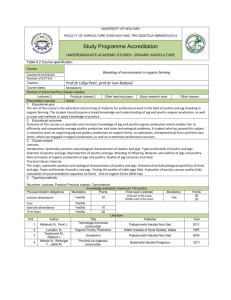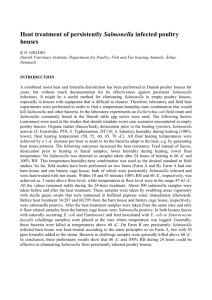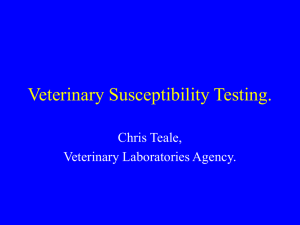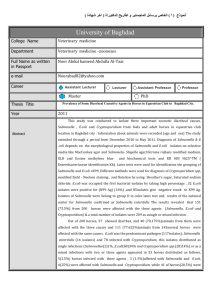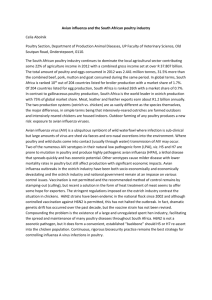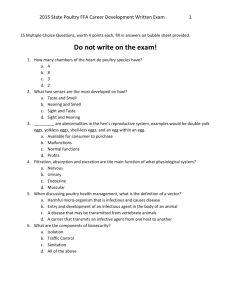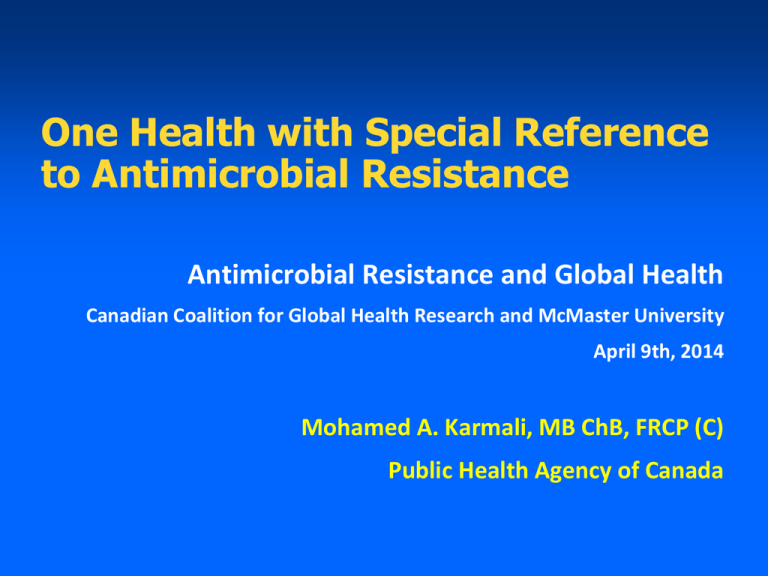
One Health with Special Reference
to Antimicrobial Resistance
Antimicrobial Resistance and Global Health
Canadian Coalition for Global Health Research and McMaster University
April 9th, 2014
Mohamed A. Karmali, MB ChB, FRCP (C)
Public Health Agency of Canada
Emerging Pathogens and Zoonoses
(Woolhouse and Gowtage-Sequerias, EID 11:1842-1846, 2005)
Of 1,407 known human pathogenic species
816 (58%) are zoonotic
Of 177 emerging or re-emerging pathogens
130 (73%) are zoonotic
Emerging and Re-emerging Pathogens
•
•
•
•
•
•
•
•
•
Ebola
SARS
West Nile Virus
HPAI
Nipah
Mers CoV
STEC/VTEC
Borellia burgdorferi
Etc.
The Concept of the Interdependence of Human Health, Animal
Health and Environmental Health is Ancient
(Wikepedia – One Health)
Hippocrates (c 460 BC to c 370) – “On Airs, Waters, and Places”
Lancisi, 17th C, Italy – integrated study of human and animal health
Villerme and Parent-Duchâtelet, early 19th C – French Public Health movement
(LaBerge, 1992)
Virchow coined the term zoonosis (19th C, Germany)
Sir William Osler(19th C) held joint Faculty positions in Medicine at McGill
University and Veterinary Medicine (U of Montréal)
Calvin Schwabe, 19th C – “One Medicine”
James Steele, 1947 established field of Veterinary Public Health at CDC
W. Karesh 2004, Wildlife Conservation Society, “One World-One HealthTM”
American Veterinary Medical Association, 2008, “One Health”
4
5
JOINT STRATEGIC FRAMEWORK ON
“One World, One Health”
(Sharm el-Sheikh, Oct. 2008)
Objectives of the Framework (2008)
● Develop surveillance capacity (national, regional, global)
● Strengthen public and animal health capacity to prevent, detect and
respond to disease outbreaks at national, regional and international
levels
● Strengthen national emergency response capability, including a global
rapid response support capacity
● Promote inter-agency and cross-sectoral collaboration and partnership
● Control HPAI and other existing/re-emerging infectious diseases
● Conduct strategic research to aid in mitigating EIDs
7
Pressures for current and future
Emergence/Re-emergence of Zoonoses
•
•
•
•
•
•
•
•
•
•
•
•
Exponential growth in human and livestock populations
Overcrowding
International travel
Rapid urbanization
Close contact between humans and animals
Environmental degradation
Closer integration between livestock and wildlife
Rapidly changing farming systems
Forest encroachment and habitat disruption
Climate and ecosystem change
Globalization of trade in animals and animal products
Conflict, mass population migration, poverty
Climate Change’s Impact on
Infectious Diseases
–
–
–
–
–
–
–
–
–
Vector-borne diseases
Water-borne diseases
Agriculture Production
Migration of Animals
Changing ecosystems for wildlife and animals
Built environment
Human-Animal Interface
Ecologies and a new research portfolio
Evidence-based public health impact
Heyman, D: Policies and Strategies to Meet the Challenge of Emerging
Disease Threat through Prevention, Preparedness and Response. 2nd
International One Health Congress Conference, Bangkok 2013
Pathogen
circulation in
the animal host
Control in animal
population where
feasible
Transmission
from animal to
human
(Emergence)
Shifting the paradigm
upstream
Prevent transmission and
Predict emergence
Infection and
Clinical impact
in human
population
Manage infection
and outbreaks in
human
populations
Riots, Rage and Resistance: A Brief History of How Antibiotics
Arrived on the Farm
Maureen Ogle, Scientific American, September 2013 (Guest Blog)
Early 20th Century saw food shortages in the US
1910, millions of Americans joined a national meat
boycott to protest prices
US government pours money into research to
stimulate production of affordable meat
In the 1940s, with of antibiotics, a discovery was made
serendipitously that sub-therapeutic doses of
antibiotics greatly stimulated animal growth
This led to a veritable food revolution which saw the
production of affordable meat in the US
11
Changes in Intestinal Flora of Farm Personnel
after Introduction of Tetracyclinesupplemented Feed on a Farm
S.B. Levy NEJM 295:583-588, 1976
• Within 5 months after chickens on a farm were fed Tetsupplemented feed, 31.3% of weekly fecal samples from farm
dwellers contained > 80% TetR bacteria
• In contrast only 6.8% samples from 24 neighbours contained
TetR bacteria (p<0.001)
• The resistant bacteria contained transferable plasmids that
encoded for multiple antibiotic resistance
Clostridium difficile in Animals
• Isolated from a variety of animals: dogs, cats,
rabbits, horses, cattle, pigs, poultry, and exotic
species (e.g., elk, cheetah, monkey, polar bears)
• Ubiquitous in the environment
• Food animals
•
•
•
Disease causing in some e.g., suckling pigs, horses
Ribotype 027/ NAP 1 (occurs in dogs, cattle, pigs but
relatively uncommon)
Ribotype 078 more common in animals but the role of
animals in dissemination remains unclear
• Food
•
•
Recovered from pork, beef, chicken, fish, raw veg
Importance? Role in dissemination?
MRSA in Animals
JS Weese. MRSA in Animals. ILA J 2010
•
•
•
•
Isolated from a variety of animals: dogs, cats, rabbits, horses, cattle,
pigs, poultry, and exotic species including whales, alpacas, rats.
Companion animals reflect prevalence of local community-acquired
MRSA; can be household reservoirs esp. dogs.
Horses – some strains of CMRSA-5 are well adapted to horses.
Food animals – some community-acquired strains but main issue is
“livestock associated” MRSA - ST398
•
•
•
•
•
Common in pigs in Europe, US, Canada, etc.
Also occurs less frequent in cattle (dairy, beef, veal); few reports for poultry
High proportion of human community cases in parts of Europe
(Netherlands, Denmark etc.) but very rare among human cases in Canada
Food – pork (~5-10%), beef (~5%), chicken (<1%)
• Importance? Role in dissemination?
Occupational risk – vets (~10-15% colonization),
farmers (~20%), slaughterplant workers etc.
Emerging Infectious Dis. 16: 587-594, 2010
ESBLs (and ESCs) in Animals
•
Use of cephalosporins and beta-lactams in food animals in Canada
•
•
•
Bla (cmy-2) relatively common in the food chain in Canada, US, Europe;
especially in poultry Salmonella and E. coli – linked to ceftiofur use in
hatching eggs
ESBLs (TEM, SHV etc.) rare in Canada in the foodchain
Pouget et al. AEM 2013 Jun;79(12):3864-6. Characterization of bla(SHV) genes on plasmids
scherichia coli and Salmonella enterica isolates from Canadian food animals (2006-2007).
from
•
CTX-M – the most significant cause of resistance to beta-lactam antibiotics
in E. coli , reported worldwide
•
U.S.
in ovo use of ceftiofur in broiler hatching eggs (extra-label use to be voluntarily
stopped by Canadian poultry industry May 2014)
Movement into the food chain also a worldwide issue; some reports in North
America but so far uncommon 2012.
Wittum et al. Detection of Salmonella enterica isolates producing CTX-M Cephalosporinase in
livestock populations. AEM 2012;78(20):7487-91.
PLoS One, 7: 1-6, May 2012; e37152
Appl. Environ. Microbiol. 78:7487-91, 2012
Annual number of human Salmonella enterica serotype Kentucky isolates per
country (France, England and Wales, and Denmark), 2000–2008, and the
proportion of isolates resistant to ciprofloxacin.
Poultry identified as a major reservoir
Le Hello S et al. J Infect Dis. 2011;204:675-684
© The Author 2011. Published by Oxford University Press on behalf of the Infectious Diseases
Society of America. All rights reserved. For Permissions, please e-mail:
journals.permissions@oup.com
Figure 1. Sources and distribution of pharmaceuticals in the environment1 (STP: sewage
treatment plant).
Kümmerer K J. Antimicrob. Chemother. 2003;52:5-7
©2003 by Oxford University Press
Acknowledgements
Richard Reid-Smith
Nick Previsich and Linda Williams


